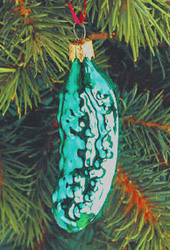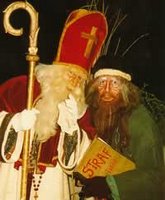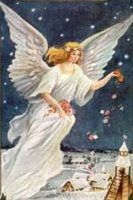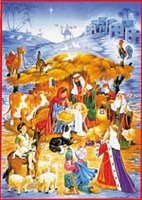I've heard of the legend of the German Christmas Pickle Ornament. This Christmas Pickle story seems to be taught in many American schools in German classes. And a little research showed me that many Americans think, the Christmas Pickle is a very important christmas tradition in Germany. If you haven't heard of that special ornament before, read on ...
A pickle is used as decoration on the Christmas tree seems odd at first, but it is an old German tradition. When decorating the Christmas tree, it is traditional to hang the pickle last, hidden among the branches. The first child on Christmas Day to find the Christmas pickle receives a special blessing for the year and an extra gift from St. Nikolaus!
 Well, as you can imagine easily, there is no such thing as a Christmas Pickle in Germany. And it never has been. In neither area of Germany people ever hung Pickles in Christmas Trees. Believe me!
Well, as you can imagine easily, there is no such thing as a Christmas Pickle in Germany. And it never has been. In neither area of Germany people ever hung Pickles in Christmas Trees. Believe me!
The Legend of the Christmas Pickle itself contains a few errors. Except the fact that the legend was made up by an American Ornament manufacturer, everything sounds like an American Christmas celebration. Because everything else in this story is more like American Christmas, since a traditional German Christmas is completely different.
Here's how Christmas is celebrated in Germany.
Real German Christmas Traditions 1. Each family has it's own Christbaum (Christmas tree). The tree is set up on December 24th--not earlier. And it'll stay in the homes till January 6th. Typical decorations are candles, Christmas ball ornaments and tinsel; sometimes (very rarely) real apples or oranges.
1. Each family has it's own Christbaum (Christmas tree). The tree is set up on December 24th--not earlier. And it'll stay in the homes till January 6th. Typical decorations are candles, Christmas ball ornaments and tinsel; sometimes (very rarely) real apples or oranges.
I can't emphasize it enough: There never was something like a Christmas Pickle. Really!
I think Americans put more things on their trees. I got a fratwork crab from a family in Maryland. She told me about a tradition in Maryland that each family makes these crabs out of wood and gives them to friends and then you hang them on your christmas tree. I still have the crab she gave me, but probably that's not a true legend either. Can anybody approve this story? 2. The Nikolaus (St. Nicholaus) in Germany delivers his presents at December 6th. When I was younger Nikolaus brought some nuts, oranges, chocolates and maybe a book or a CD. Small gifts only. I guess Nikolaus earns more money now, because the gifts he's delivering recently are getting bigger and more expensive. Anyway, he delivers only to children who were nice during the entire year. Nasty children however got spanked by "Knecht Ruprecht", his menial. "Just wait until Ruprecht comes" is still a common threat in German homes. Although there are no reports of children that really got spanked, Nikolaus is still commanding respect. When I was about 3 or 4 years old I was afraid of Nikolaus, although I've always been nice.
2. The Nikolaus (St. Nicholaus) in Germany delivers his presents at December 6th. When I was younger Nikolaus brought some nuts, oranges, chocolates and maybe a book or a CD. Small gifts only. I guess Nikolaus earns more money now, because the gifts he's delivering recently are getting bigger and more expensive. Anyway, he delivers only to children who were nice during the entire year. Nasty children however got spanked by "Knecht Ruprecht", his menial. "Just wait until Ruprecht comes" is still a common threat in German homes. Although there are no reports of children that really got spanked, Nikolaus is still commanding respect. When I was about 3 or 4 years old I was afraid of Nikolaus, although I've always been nice. 3. Children in Germany don't get their presents at Christmas Day. In Germany the presents are brought by the Christkind ("christ child") on Christmas Eve. The Christkind puts them under the Christmas Tree while nobody's in the room.
3. Children in Germany don't get their presents at Christmas Day. In Germany the presents are brought by the Christkind ("christ child") on Christmas Eve. The Christkind puts them under the Christmas Tree while nobody's in the room.
Children are allowed to open their presents right after dinner on Christmas Eve. Traditionally it wasn't a big dinner on Christmas Eve. In my state sausages and potato salad is quite typical. My grandparents always had sausages and potato salad. My parents however never made sausages, instead we often had a special pastry filled with chicken and mushrooms which is still one of my favourite dishes today. Today many families have Raclette or Fondue on Christmas Eve. 4. During the four weeks before Christmas, everybody has a Adventskranz (advent wreath) at home. The linked article on Wikipedia is showing a picture of a typical Adventskranz. However, the explanation on Wikipedia is not correct for Germany. Here's the real thing: It is a ring or set of four candles, usually made with evergreen cuttings. Then the candles are lit in succession through the four weeks leading up to Christmas. Each sunday one more candle is lit. The color of the candles doesn't matter. Most common color of the candles is red. And usually they're all the same color.
4. During the four weeks before Christmas, everybody has a Adventskranz (advent wreath) at home. The linked article on Wikipedia is showing a picture of a typical Adventskranz. However, the explanation on Wikipedia is not correct for Germany. Here's the real thing: It is a ring or set of four candles, usually made with evergreen cuttings. Then the candles are lit in succession through the four weeks leading up to Christmas. Each sunday one more candle is lit. The color of the candles doesn't matter. Most common color of the candles is red. And usually they're all the same color. 5. Each child has an Adventskalender (advent calendar). It has 24 little doors with numbers from 1 to 24. On the 1st of Dezember the first door is opend, then each day another one. When the last door is opened it's Christmas Eve and the children get their presents. Behind the doors there are either some pictures, but most commonly there are chocolates or other treats.
5. Each child has an Adventskalender (advent calendar). It has 24 little doors with numbers from 1 to 24. On the 1st of Dezember the first door is opend, then each day another one. When the last door is opened it's Christmas Eve and the children get their presents. Behind the doors there are either some pictures, but most commonly there are chocolates or other treats.
Kommentare
My family is of German heritage, and while we've l...
My family is of German heritage, and while we've lived in the United States since the mid-1800s, parts of our Christmas celebrations still resemble what you describe here. Specifically, my family opens presents on Christmas Eve, and when I was a child, we got our stockings on St. Nicholas Day, and my sister and I always got a chocolate Advent calendar. None of these are parts of a typical American Christmas observance.
And, yes, I have that exact same pickle ornament.
A German Christmas sounds like a lot of fun! Thank...
A German Christmas sounds like a lot of fun! Thanks for teaching us about the pickle ornament!
German christmas' sound so different to the ones i...
German christmas' sound so different to the ones in New Zealand. We more or less share the traditions of Britain. Presents are opened on December 25th in the morning and no acknowledgement of 6th December exists.
German christmas' sound like fun.
Have a great weekend.
Kevin in New Zealand.
I wonder if it will work today? I have been having...
I wonder if it will work today? I have been having more trouble leaving comments on your blog. Blogger won't let me!
I think I have a pickle ornament somewhere. Not German, eh? It does sound like an American gimmick. I grew up in Pittsburgh with the Heinz Pickle Factory and I bet they had something to do with it.
The German traditions sound wonderful. Wish I could get there someday and be able to see them for myself. I like the idea of candles on the tree. How do you attach them so they don't fall over?
The only tradition I remember is that we used to burn a bayberry candle on Christmas eve. You have to let it burn through the night all the way down. I think it is supposed to bring good luck. I don't think it ever worked in my family, but we tried!
Candles are attached with a
Candles are attached with a special clip that has a candle holder on it. I wouldn't try it on the trees we get here in Canada and the U.S. The typical German Weihnachtsbaum has space above the candle so you don't start a fire. It looks very pretty, doesn't it?
Thank you, Rian, for this great post! It's a cultu...
Thank you, Rian, for this great post! It's a cultural lesson indeed.